Main Street Report
The Experian Main Street Report brings deep insight into the overall financial well-being of the small-business landscape, as well as providing commentary around what specific trends mean for credit grantors and the small-business community. Critical factors in the Main Street Report include a combination of business credit data (credit balances, delinquency rates, utilization rates, etc.) and macroeconomic information (employment rates, income, retail sales, industrial production, etc). The Main Street Report is published quarterly.
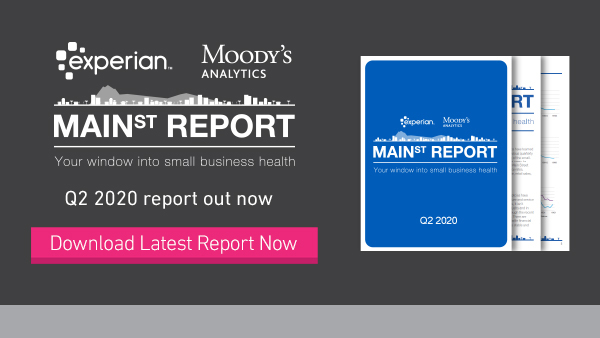
Experian and Moody's Analytics have just released the Q2 2020 Main Street Report. The report brings deep insight into the overall financial well-being of the small-business landscape, as well as offer commentary on business credit trends, and what they mean for lenders and small-businesses. Small businesses have turned to borrowing to survive periods of prolonged slumping sales, in many cases from government programs offering loan forgiveness. This increased borrowing has masked rising delinquent balances, but such a solution is a short-term fix. To keep their credit current, small businesses will need to find ways to generate revenue. Defaults are expected to rise in coming quarters as forbearance programs expire and as customers are likely to change their priorities in the wake of COVID-19. In Q2, moderate delinquency, defined as 31-90 days past due, rose to 1.66 percent from 1.61 percent, marking the fourth consecutive quarter of increasing delinquency, and the first year-over-year increase since this time last year. The closure of many state and local economies in April and the first half of May left many businesses facing severe revenue shortfalls in the second quarter. This environment has resulted in businesses listing poor sales as the second most important problem facing small businesses, according to the NFIB. If you would like to get the full analysis of the data behind the latest Main Street Report, presented by leading economists from Moody's Analytics and Experian, watch the Quarterly Business Credit Review webinar.
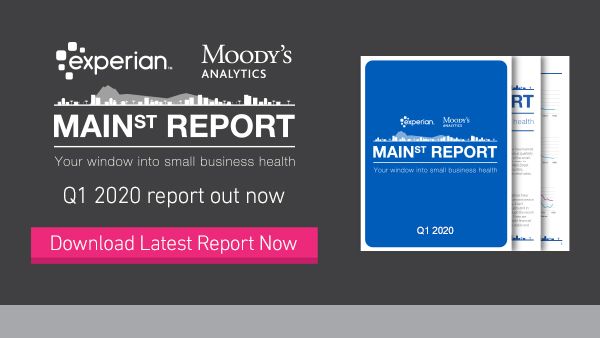
Experian and Moody's Analytics have just released the Q1 2020 Main Street Report. The report brings deep insight into the overall financial well-being of the small-business landscape, as well as offer commentary on business credit trends, and what they mean for lenders and small-businesses. After just one quarter, there’s no doubt the theme of 2020 is the pandemic, Covid-19. Unrelated to the pandemic, and subsequent shuttering of a swath of economies across the world, delinquencies rose in the first quarter. This was occurring as businesses reduced their borrowing. Lower borrowing will not have lasted long though, as government efforts to aid small business have taken the form of SBA lending. In Q1, the slowing of businesses pursuing credit pushed moderately delinquent balances up to 1.61 percent from 1.60 percent in the fourth quarter of 2019. # DPD Q1 19 Q4 19 Q1 20 Moderately delinquent 31–90 1.74% 1.60% 1.61% Severely delinquent 91+ 3.35% 2.29% 2.68% Bankruptcy 0.16% 0.16% 0.16% The bankruptcy rate was essentially flat in the first quarter, rising to 16.3 basis points from 16.1 in Q4. But the rate increased as fewer firms were reported as having active credit balances. The Federal Reserve’s Senior Loan Officer Survey indicates lenders are seeing higher demand than usual for Commercial & Industrial loans. This indicates the beginning of increasing loan demand this year, as small firms look to borrow to ride out lower consumer demand and remain in business. Watch the Quarterly Business Credit Review Get the full analysis of the data behind the Main Street Report by watching the experts from Experian and Moody’s in the Quarterly Business Credit Review.
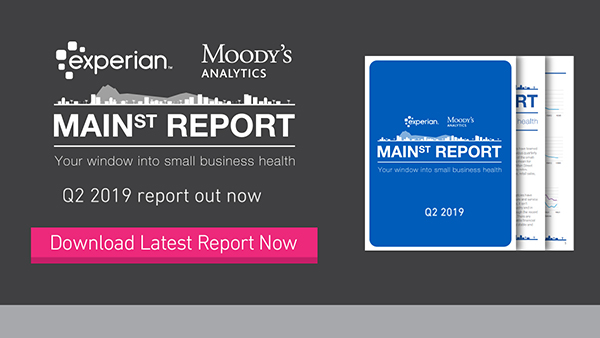
Experian and Moody’s Analytics have just released the Q2 2019 Main Street Report. The report brings deep insight into the overall financial well-being of the small-business landscape, as well as providing commentary on what certain trends mean for lenders and small businesses. Q2 Highlights In spite of business confidence in the second quarter, shaken by talk of trade war escalation, small businesses got a helping hand from seasonal factors that combined to push delinquency rates down. Delinquency rates for businesses with fewer than 100 employees fell in the second quarter, decreasing the 31–90 days past due rate from 1.74 percent to 1.64 percent for the quarter. But agriculture’s problems continued as weather and trade conditions continued to weigh on small farms. These factors won’t be as helpful in the third quarter, so fundamentals or confidence will need to improve to propel performance and growth forward. Bankruptcies ticked up ever so slightly again in the second quarter coming in at over 16 basis points. The most recent data available, from Q4 2018, indicates an establishment growth rate of 2.3%. Enough of these new businesses will seek credit to ensure that, combined with existing borrowers, balances look set to grow for some time. Overall, small businesses continue to display little to no signs of broad-based weakness. What weakness exists is fairly well confined at either the regional or industry level, and the solid performance that has been the norm for the last several quarters looks set to continue. Watch Webinar Recording Experian and Moody's Analytics go in-depth on the Q2 2019 Main Street Report in the below webinar.
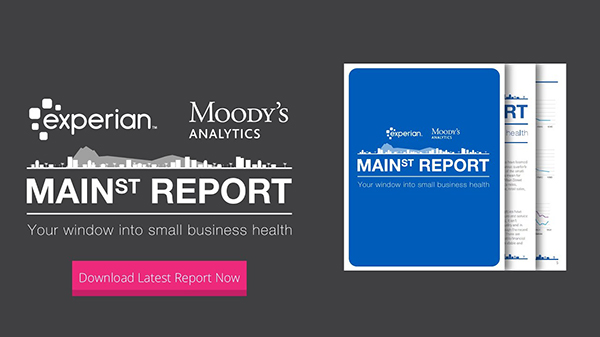
Experian and Moody’s Analytics have just released the Q1 2019 Main Street Report. The report brings deep insight into the overall financial well-being of the small-business landscape, as well as providing commentary on what certain trends mean for lenders and small businesses. In Q1 U.S. small businesses brushed off a government shutdown as stock markets recovered and income gains remained steady. Delinquency rates remained mostly stable, with pockets of weakness spread out among regions and industries, notably agriculture in the Great Lakes and manufacturing in the Southwest. Small firms seem to have simply shrugged off the headwinds of the first quarter and kept on with business as usual. Despite a fresh escalation in trade tensions, the year is starting off well with positive news coming from the areas presenting risks to the outlook. A dovish stance on interest rates from the Federal Reserve and room to grow in our housing market — 2019 is off to a strong start. Watch Webinar Recording - Q1 2019 Quarterly Business Credit Review Listen to the experts from Experian and Moody's Analytics go in-depth on insights revealed in the Q1 2019 Experian/Moody's Analytics Main Street Report.
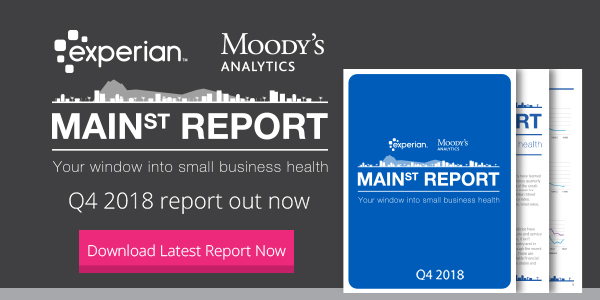
Experian has released the Experian/Moody's Analytics Main Street Report for Q4 2018. The report brings deep insight into the overall financial well-being of the small-business landscape, as well as providing commentary around what certain trends mean for credit grantors and the small-business community. Bucket 17Q4 18Q3 18Q4 Moderately Delinquent 31-90 1.68% 1.63% 1.68% Severely Delinquent 91+ 4.00% 3.40% 3.49% Bankruptcy BKC 0.16% 0.16% 0.16% The fourth quarter capped a second year of solid performance and growth for small-business credit, but there are signs that the period of moderation experienced during the past two years is over. Since the government shutdown has the potential to throw small-business lending a curve ball in the first half of 2019, the outlook for small-business credit is neutral. Conditions were positive in the fourth quarter, but this may not last long. Delinquency rates remained mostly stable, with pockets of weakness spread out among regions and industries, notably construction in the Plains. In addition to the 35-day shutdown, rising interest rates, destabilizing trade policy and slowing home-price growth are potential trouble sources that are already starting to impact some regions.
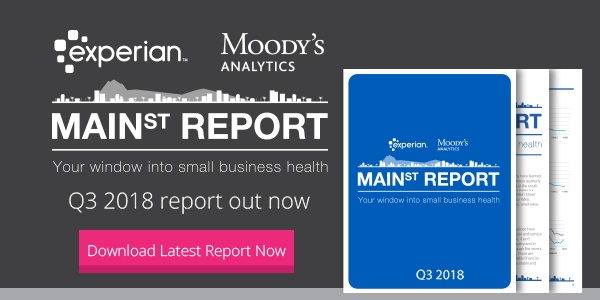
Today Experian and Moody's Analytics released the Q3 2018 Main Street Report. The report brings deep insight into the overall financial well-being of the small-business landscape, as well as providing commentary around what certain trends mean for credit grantors and the small-business community. For Q3 2018, the overall outlook for small-business credit is positive, but some industries such as construction have a negative outlook. Delinquency rates stable for now Delinquency rates are stable around their current levels, but this could change quickly if risks mount for certain industries. Continuing strength in the economy should keep small-business credit performance in check through the fourth quarter and early next year. Rising interest rates, destabilizing trade policy and slowing home-price growth are potential sources of trouble that are already starting to impact some regions. To bring insight to these Q3 business credit findings, Experian and Moody's Analytics will be presenting the Quarterly Business Credit Review for Q3 2018 on Tuesday, December 11th 10:00 a.m. (Pacific) 1:00 p.m. (Eastern). Read the report and bring your questions, we will be opening up the session for live Q&A as we dig into the numbers and the outlook for Q4 2018. We hope to see you there. Presenters: Gavin Harding Derrek G. McCrank Cristian deRitis
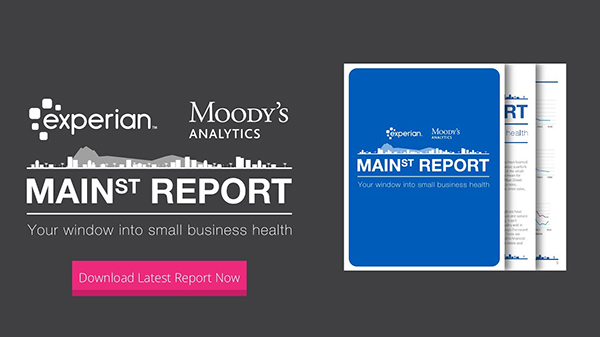
Today Experian Business Information Services releases the Experian/Moody's Analytics Main Street Report for Q1 2018. The report brings deep insight into the overall financial well-being of the small-business landscape, as well as providing commentary around what certain trends mean for credit grantors and the small-business community. Q1 2018 saw credit conditions loosening and balances rising as more businesses access credit. The report states the overall outlook for small-business credit is positive. Delinquencies were down and default rates rose slightly, suggesting that credit conditions have peaked as the economy is in a late-cycle expansion. Continuing strength in the macroeconomy will keep small-business credit moving in the near term, along with higher profits from the recently passed tax legislation. Small-business credit will be less certain in the medium to long term as rising wages, interest rates and changes to the tax code take a toll. Download the latest report
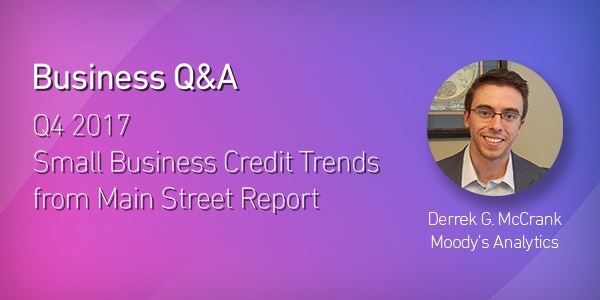
Gary Stockton: Experian has just released the Q4 2017 Main Street Report. We partner with Moody's Analytics on this report each quarter, and Derrek Grunfelder-McCrank is the economist who works on the report. We asked him a few questions about the trends that we're seeing in this quarter's data. Gary Stockton: The latest Main Street Report states that small business credit conditions remain positive. Is there a primary factor that's driving this stability? Derrek G. McCrank: Yeah there certainly is Gary. The primary factor that's driving stability in small business credit is the broader U.S. economy. Right now we have the labor market that's tight. This is resulting in wage increases for consumers as a result. Consumer spending has been reliable. Inflation is starting to pick up in a slow steady manner. On top of it all at the end of last year we just got tax reform. Right now the outlook for small business credit is positive. And that doesn't look set to change anytime soon. Gary Stockton: and are you seeing greater numbers of small businesses investing in that business by borrowing for equipment purchases? Derrek G. McCrank: Well Gary while we can't say for certain. The data seems to suggest that this isn't happening to the extent it could just yet. One of the questions in the NFIB's monthly survey is about whether firms are planning capital expenditures in the next three to six months. Since the end of the last recession. We've seen the positive response rate to this question steadily increasing. However it still sits below its long term average. Couple this with tax reform coming so late at the end of last year, and a decent number of firms are likely to have waited until the new year when they could invest in their business with a little more certainty. Gary Stockton: Well historically small businesses been keeping bankruptcy in check, but this quarter we saw it up slightly. Is this a major concern? Derrek G. McCrank: This isn't a cause for concern yet. Though it is something to monitor going forward. In the first quarter of 2017 the small business bankruptcy rate bottomed out, it hi its floor. As the year progressed, the bankruptcy rate moved off of that floor and that appears to be all that happened. In fact I'm hopeful that this might indicate a return to a more dynamic environment for small businesses which I look forward to discussing in a little more detail and our upcoming webinar. But for now, given the state of the economy, I'm optimistic for the state of small business credit. Gary Stockton: On the flip side, the Northeast saw a steep decline in business bankruptcies in Q4. Can you share some insight on what might be driving that? Derrek G. McCrank: Sure, so in the fourth quarter. the Northeast saw declines in its severely delinquent or 90 days past due rate coupled with a slight uptick in its business bankruptcy rate. What happened with business bankruptcies mirrored the trend nationally, so it shouldn't be a cause for concern this year, the declines in the severely delinquent rate were driven by two primary factors - geography and industry, from a geographic point of view, Connecticut, New Hampshire and Maine were the driving forces behind the reductions in severe delinquency, and from an industrial point of view financial services, public administration and the manufacturing industries are credited with declines in severe delinquency. Download the latest report
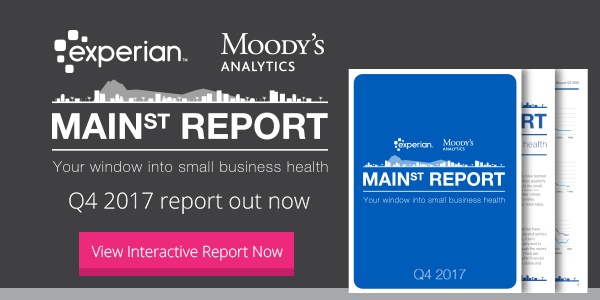
Experian and Moody’s Analytics just released the latest Experian/Moody’s Analytics Main Street Report for Q4 2017. The report brings deep insight into the overall financial well-being of the small-business landscape, as well as providing commentary around what certain trends mean for credit grantors and the small-business community. The overall outlook for small-business credit is positive. Outstanding balances rose in the fourth quarter, as did the average balance outstanding per business. Delinquency and default rates rose slightly, suggesting that credit conditions have loosened. Continuing strength in the macroeconomy will keep small businesses moving in the near term, along with higher profits from the recently passed tax legislation. Small-business credit will be less certain in the medium to long term as rising wages and tax code changes take a toll. Northeast sees the steepest decline in delinquency The Northeast saw the steepest decline in severe delinquencies in the fourth quarter, and construction was one of the industries responsible for that trend. Many small construction firms have a focus on residential projects, making consumer credit growth an ideal metric to use as a basis for understanding what’s happening and what will happen in the industry. We have published the entire contents of the report in an interactive page, complete with charts and graphs. Download Main Street Report
